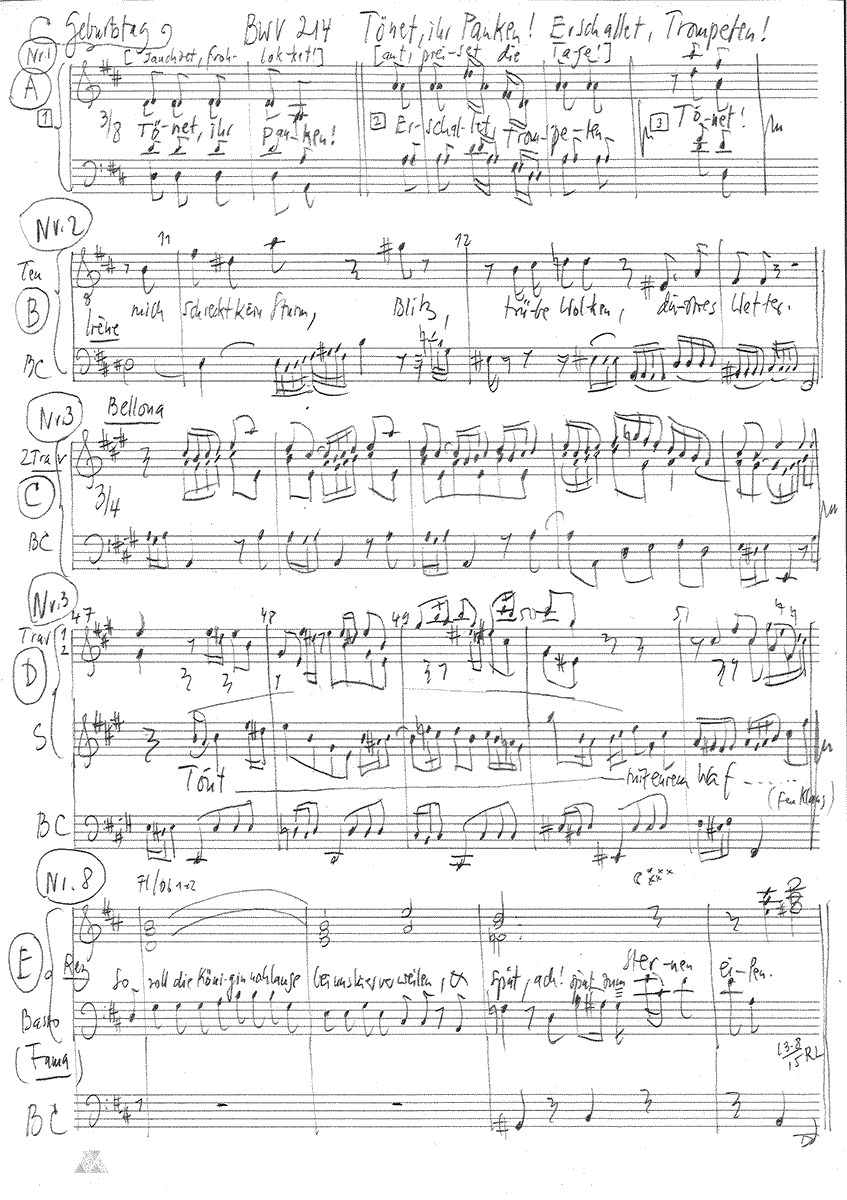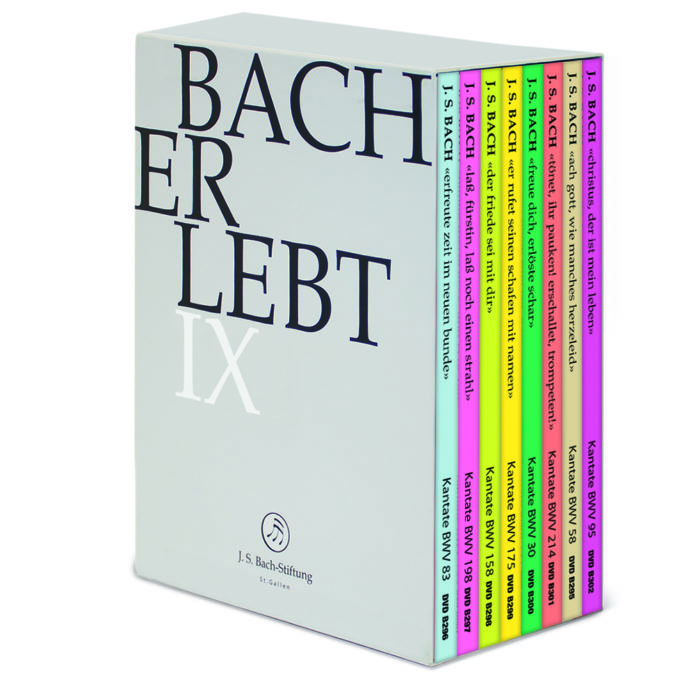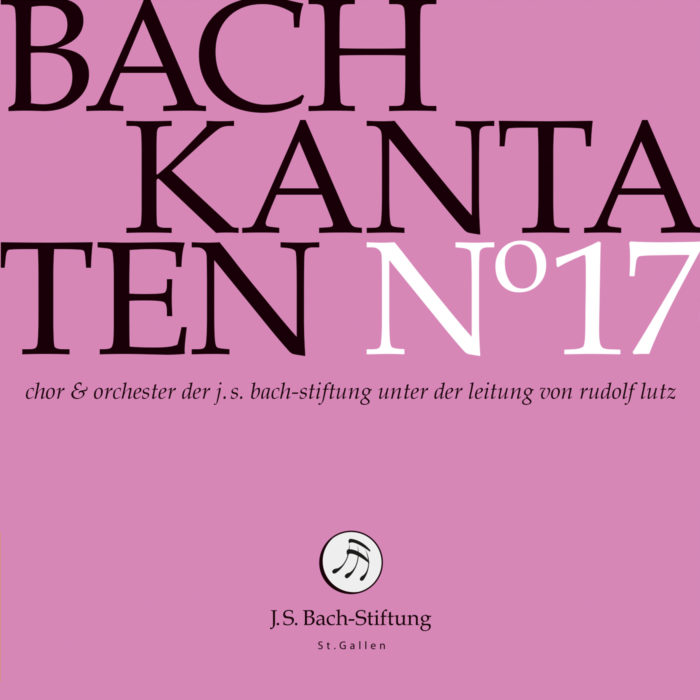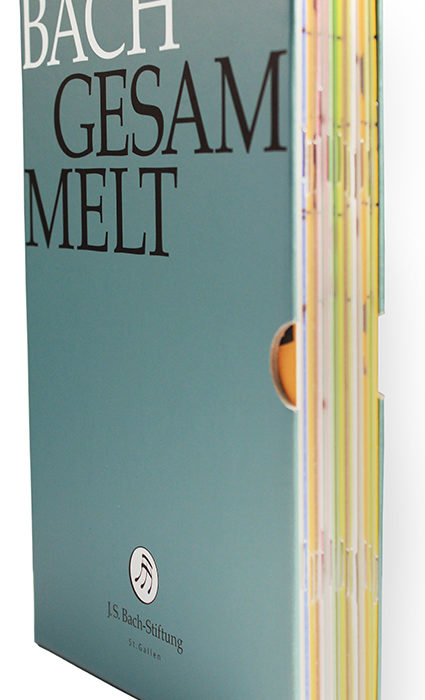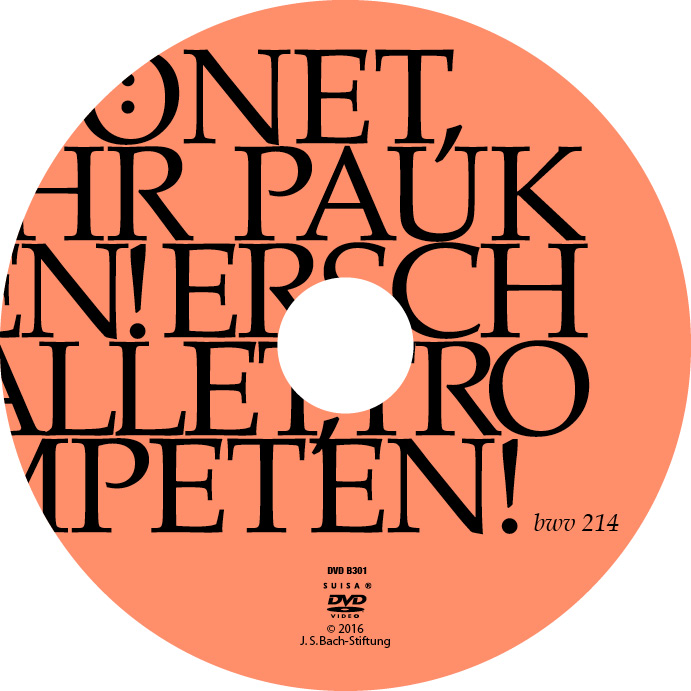Tönet, ihr Pauken, erschallet, Trompeten
BWV 214 // Secular occasional music
(Sound, all ye drums now! Resound, all ye trumpets!) for soprano, alto, tenor and bass, transverse flute I+II, oboe I+II, timpani, strings and basso continuo
The words “Jauchzet, frohlocket!” (Triumph, rejoicing!) open one of Bach’s most instantly recognised works: the introductory chorus of the Christmas Oratorio BWV 248, which is indeed a parody of the homage cantata BWV 214. The Christmas Oratorio’s cleverly reworked libretto by Picander, however, conceals the convincing inner logic of the original work. Opening with the ringing words of “Sound, all ye drums now! Resound, all ye trumpets! Resonant viols, make swell now the air!”, the libretto of BWV 214 powerfully introduces the baroque festival orchestra and paves the way for a cantata whose strong military overtones were inspired by the sabrerattling events of the day.
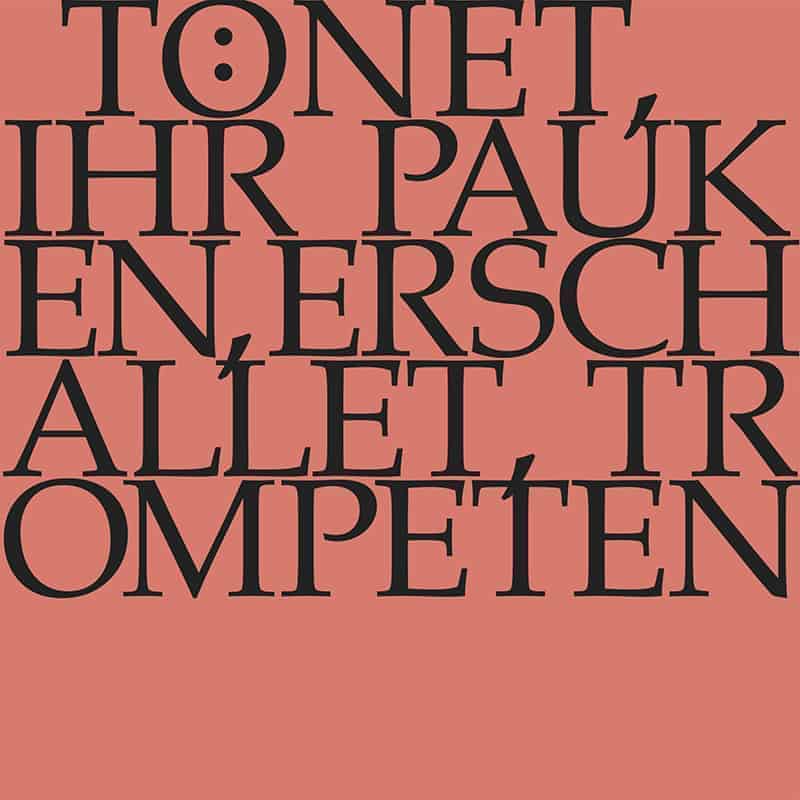
Would you like to enjoy our videos ad-free? Subscribe to YouTube Premium now...
Workshop
Reflective lecture
Soloists
Soprano
Johannette Zomer
Alto
Michaela Selinger
Tenor
Johannes Kaleschke
Bass
Klaus Mertens
Orchestra
Conductor
Rudolf Lutz
Violin
Renate Steinmann, Monika Baer, Yuko Ishikawa, Elisabeth Kohler, Ildikó Sajgó, Anita Zeller, Salome Zimmermann
Viola
Susanna Hefti, Florian Mohr, Martina Zimmermann
Violoncello
Martin Zeller, Bettina Messerschmidt
Violone
Markus Bernhard
Oboe
Thomas Meraner, Ingo Müller
Oboe d’amore
Thomas Meraner
Bassoon
Susann Landert
Tromba da tirarsi
Patrick Henrichs, Peter Hasel, Pavel Janecek
Transverse flute
Claire Genewein, Tomoko Mukoyama
Timpani
Martin Homann
Harpsichord
Thomas Leininger
Musical director & conductor
Rudolf Lutz
Workshop
Participants
Anselm Hartinger, Rudolf Lutz
Reflective lecture
Speaker
Thomas Rosenlöcher
Recording & editing
Recording date
14/08/2015
Recording location
Rorschach SG (Schweiz)
Sound engineer
Stefan Ritzenthaler
Director
Meinrad Keel
Production manager
Johannes Widmer
Production
GALLUS MEDIA AG, Switzerland
Producer
J.S. Bach Foundation of St. Gallen, Switzerland
Librettist
Text No. 1
Poet unknown (perhaps Christian F. Henrici, known as Picander)
First performance
8 December 1733, Leipzig
In-depth analysis
The words “Jauchzet, frohlocket!” (Triumph, rejoicing!) open one of Bach’s most instantly recognised works: the introductory chorus of the Christmas Oratorio BWV 248, which is indeed a parody of the homage cantata BWV 214. The Christmas Oratorio’s cleverly reworked libretto by Picander, however, conceals the convincing inner logic of the original work. Opening with the ringing words of “Sound, all ye drums now! Resound, all ye trumpets! Resonant viols, make swell now the air!”, the libretto of BWV 214 powerfully introduces the baroque festival orchestra and paves the way for a cantata whose strong military overtones were inspired by the sabrerattling events of the day. After the death of August the Strong on 1 February 1733, his son and heir in Sachsen, electoral prince Friedrich August II, was forced to fight the powerful anti-king Stanislaus Lesczynski to ascend to the Polish throne. Indeed, the coronation journey of Friedrich August to Cracow in January 1734 – undertaken separately from his wife, archduchess Maria Josepha, for security reasons – was less a triumphal procession than a military expedition beset with risks and nightly skirmishes. The new queen therefore certainly understood the “clanging metal” and thundering artillery of the cantata not as mere symbolic gestures, but as the real dangers that she ably conquered by virtue of her royal descent and innate heroic merits.
The cantata, which premiered in Leipzig on 8 December 1733 in honour of Maria Josepha’s birthday, derives its essence from a dramatic tension between the elements of joyous praise, advocacy of peace, and defiant perseverance in the face of adversity and clamour of battle. The libretto thus employs three contrasting allegorical figures: Fama, Bellona and Irene. Given this constellation, it is no surprise that the festive joy of recitative no. 2 is soon countered by thunderous, stormy gestures, and the tender sound of the transverse flute in the soprano aria “Blow the welltuned, well-played flutes now!” must struggle to prevail amid the setting’s edgy, fife-like military tone. Here, the cryptic mention of “lilies”, the “moon” and the “foe” evidently refers to the coat of arms of the French Bourbons and the Turkish Sultan, supporters of rival Leszcynski. The collective enemy is then thwarted in the combative recitative no. 4 by the “flashing arms” of the Saxons, who, despite their confessional differences, stood united in battle behind their royal leader.
The battle rhetoric of the opening movements renders the shift to the introverted alto aria all the more effective. Accompanied by the dulcet tones of the oboe d’amore, Pallas Athena, goddess of the arts and wisdom, summons the collected Muses to “sing not long out-moded anthems” and “cast aside both quill and tablets” in honour of the queen’s jubilee. Viewed figuratively as a reflection on royal duties, this movement is a well-placed reminder to the regent to support not only warfare, but also the arts; here, the composer and librettist, relatively unknown to the court, audibly draw attention to their humble services. In this sense, recitative no. 6, accompanied by a ceremonious string setting, represents more an optimistic evocation of a future court devoted to the muses than a description of the benefactions received to date.
Like the opening movement, the ensuing aria di bravura, “Crown and star of crownéd ladies”, is better known in its Christmas Oratorio version: “Grosser Herr, o starker König” (Mighty Lord, O strongest sovereign). Written for bass, trumpets and strings, the inspired setting couples short, catchy melodies with an expansive arc of suspense that effectively fills the “the orb of earth” described in the libretto.
The bass recitative by Fama then takes up this heroic gesture, aided by inflated geographic and astronomical analogies, ere the setting closes with a surprisingly subdued and sincere plea for the queen’s longevity.
The resounding tutti closing chorus, featuring an identical repeat, serves to unite the allegorical figures and their respective blessings. And it is a setting that represents one of Bach’s most powerful inventions – no doubt the ambitious master composer, here at the height of his stylistic powers, was recommending himself for new duties. Indeed, in contrast to the choral nature of the Christmas Oratorio, BWV 214 stands out for its highly soloistic form that lends the secular homage cantata precisely the elegance of style that graced the courtly serenades and operas of the time.
Libretto
1. Chor
Tönet, ihr Pauken! Erschallet, Trompeten!
Klingende Saiten, erfüllet die Luft!
Singet itzt Lieder, ihr muntren Poeten,
Königin lebe! wird fröhlich geruft.
Königin lebe! dies wünschet der Sachse,
Königin lebe und blühe und wachse!
2. Rezitativ (Tenor; Irene)
Heut ist der Tag,
wo jeder sich erfreuen mag.
Dies ist der frohe Glanz
der Königin Geburtsfests-Stunden,
die Polen, Sachsen und uns ganz
in größter Lust und Glück erfunden.
Mein Ölbaum
kriegt so Saft als fetten Raum.
Er zeigt noch keine falbe Blätter;
mich schreckt kein Sturm, Blitz,
trübe Wolken, düstres Wetter.
3. Arie (Sopran; Bellona)
Blast die wohlgegriffnen Flöten,
daß Feind, Lilien, Mond erröten,
schallt mit jauchzendem Gesang!
Tönt mit eurem Waffenklang!
Dieses Fest erfordert Freuden,
die so Geist als Sinnen weiden.
4. Rezitativ (Sopran; Bellona)
Mein knallendes Metall
der in der Luft erbebenden Kartaunen,
der frohe Schall;
das angenehme Schauen;
die Lust, die Sachsen itzt empfindt,
rührt vieler Menschen Sinnen.
Mein schimmerndes Gewehr
nebst meiner Söhne gleichen Schritten
und ihre heldenmäßge Sitten
vermehren immer mehr und mehr
des heutgen Tages süße Freude.
5. Arie (Alt; Pallas)
Fromme Musen! meine Glieder!
singt nicht längst bekannte Lieder!
Dieser Tag sei eure Lust!
Füllt mit Freuden eure Brust!
Werft so Kiel als Schriften nieder
und erfreut euch dreimal wieder!
6. Rezitativ (Alt; Pallas)
Unsre Königin im Lande,
die der Himmel zu uns sandte,
ist der Musen Trost und Schutz.
Meine Pierinnen wissen,
die in Ehrfurcht ihren Saum noch küssen,
vor ihr stetes Wohlergehn
Dank und Pflicht und Ton stets zu erhöhn.
Ja, sie wünschen, daß ihr Leben
möge lange Lust uns geben.
7. Arie (Bass; Fama)
Kron und Preis gekrönter Damen,
Königin! mit deinem Namen
füll ich diesen Kreis der Welt.
Was der Tugend stets gefällt,
und was nur Heldinnen haben,
sein dir angeborne Gaben.
und erfreut euch dreimal wieder!
8. Rezitativ (Bass; Fama)
So dringe in das weite Erdenrund
mein von der Königin erfüllter Mund!
Ihr Ruhm soll bis zum Axen
des schön gestirnten Himmels wachsen,
die Königin der Sachsen und der Polen
sei stets des Himmels Schutz empfohlen.
So stärkt durch sie der Pol
so vieler Untertanen längst erwünschtes Wohl.
So soll die Königin noch lange
bei uns hier verweilen
und spät, ach! spät zum Sternen eilen.
9. Chor
Irene:
Blühet, ihr Linden in Sachsen, wie Zedern!
Bellona:
Schallet mit Waffen und Wagen und Rädern!
Pallas:
Singet, ihr Musen, mit völligem Klang!
Alle:
Fröhliche Stunden, ihr freudigen Zeiten!
gönnt uns noch öfters die güldenen Freuden:
Königin, lebe, ja lebe noch lang!



